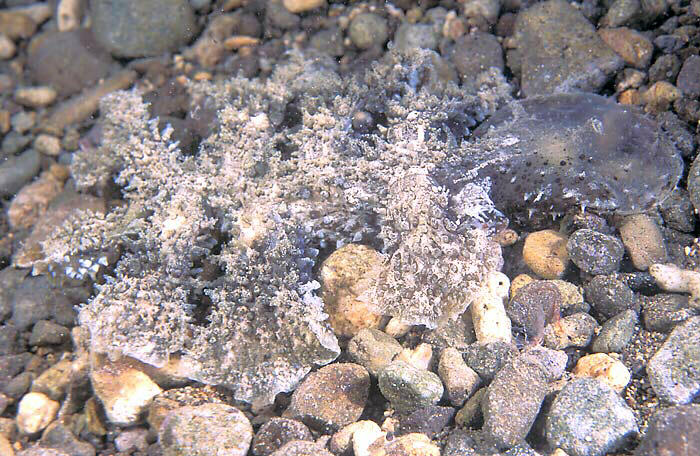 |
Melibe mirifica
Photo courtesy of Jeff RosenfeldJust look at this magnificent creature. One should expect that it is a member of the wild and wooly family Tethydidae. Like other Melibe's, Melibe mirifica has large spatula shaped cerata and huge oral hood. The hood is used for feeding on all sorts of motile critters swimming just above the substrate. Like Melibe leonina from the Pacific coast of North America, Melibe mirifica expands the hood and heaves it in front of itself, almost like a Hawaiian fisherman's throw net. It then contracts the edges of the hood trapping amphipods, copepods and even small fish.
This species reaches up to 30 cm in length, an impressive animal. You can see from Jeff's photo that it can be quite cryptic, blending into the bottom substrate very well. On sandy bottoms the tuberculate cerata blend closely to make specimens resemble the bottom perfectly. The cerata may contain symbiotic zoozanthellae which provide supplemental nutrition to the nudibranch by carrying out photosynthesis within the animal's tissue. They can also propel the critter into the water column, making this species a great swimmer.
A closely related and co-occurring species is Melibe fimbrata Alder & Hancock, 1864, which can be seen on page 173 of Coral Reef Animals of the Indo-Pacific .
Found throughout the Indo-Pacific, this species is found in numerous habitats, but usually sandy bottoms, where it has been found with another wild carnivore, Kalinga ornata .
Danville, Calif
Jun., 2002

|
By vocation, Jeff Rosenfeld is the Technology Coordinator for a high school in Seattle, Washington. In his spare time, he loves to travel. Jeff began diving in 1994 and taking underwater photos in 1995. Among his favorite destinations are the Philippines, Solomon Islands, Indonesia, and a bit closer to home, Vancouver Island. Jeff maintains a web site of his underwater photography called The Vibrant Sea . Jeff has the following to say about the locality of this Nudibranch of the Week. "...Few places in the world better demonstrate the ocean's truly amazing ability to withstand man's best efforts to destroy it better than Anilao, Philippines. Located a mere 3 hour drive south of Manila, Anilao represents to me, better than any other location I've visited, the potential humans have on the sea. In Anilao, marine identification books are only of so much use as one constantly comes into contact with creatures that simply have not yet been discovered or in the least, formally named. Even though hundreds of thousands, if not millions, of divers have visited these waters, scientists still constantly identify new species on Anilao's reefs. When it comes to sheer diversity of macro creatures, I've simply never encountered any single location quite like Anilao. From the truly bizarre that one can find nightly at a dive site like Basura to the pristine beauty of a reef such as Beatrice, Anilao simply offers mind-blowing macro diversity..."
|
Taxonomic information courtesy of:

David W. Behrens
Author:
Pacific Coast Nudibranchs
Send Dave mail at seachalleng@earthlink.net
|
